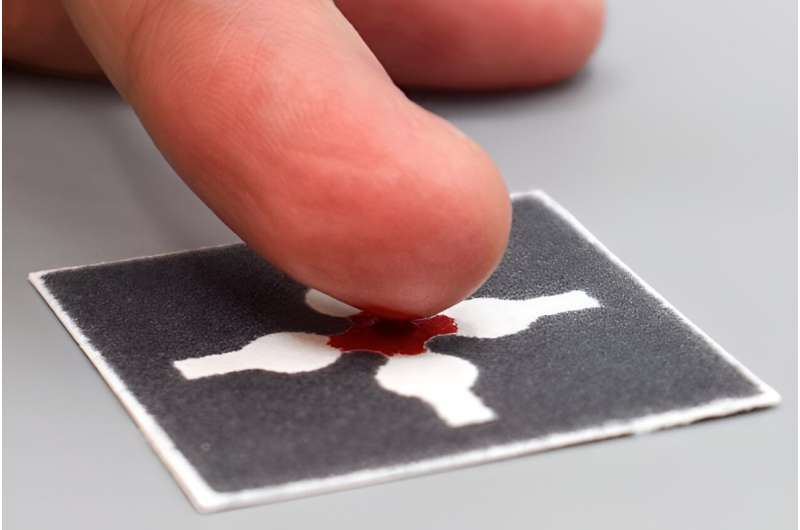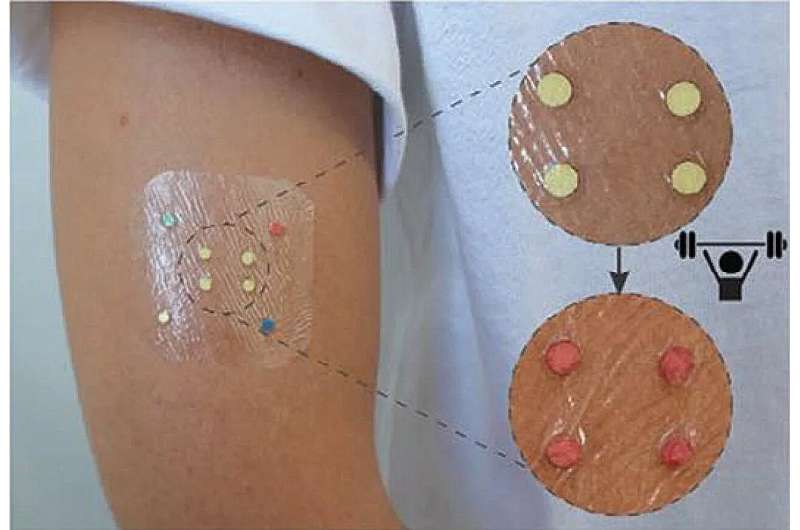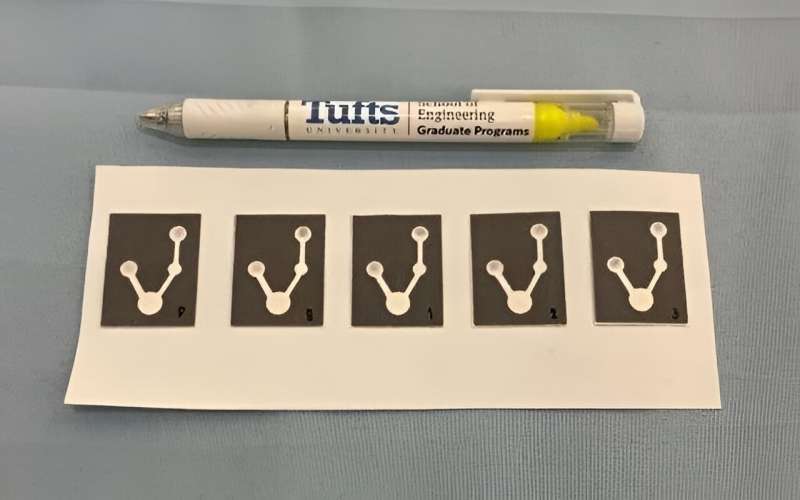This article has been reviewed according to Science X's editorial process and policies. Editors have highlighted the following attributes while ensuring the content's credibility:
fact-checked
peer-reviewed publication
trusted source
proofread
Blood, sweat, and water: New paper analytical devices easily track health and environment

When you need to measure white blood cell counts, it usually involves trips to clinics and expensive equipment for analysis. Likewise, checking water quality for contaminants can be a lengthy process.
But now Tufts researchers are coming up with ways to do some of these tests that greatly lowers cost and makes them more widely available. They are using something ubiquitous: paper. Their innovative paper-based tests for monitoring personal health and environmental safety eliminate the need for expensive laboratory equipment, and can be conducted by anyone, anywhere.
Known as paper analytical devices, they can be manufactured cheaply, stored for long periods of time, distributed for use in remote areas, and used to collect critical information when and where it is needed the most. They also each represent a technology platform that can be extended to measure other markers for health and the environment.
Take one of the most vital measurements in health care: the blood cell count. Measuring white blood cells alone gives clues to everything from infections to autoimmune disease to cancer. Although sample collection—a blood draw—seems simple, it requires a visit to a clinic and access to centralized clinical laboratories for analysis. Large populations of people—those who are homebound or live in remote locations—do not have that access.
Charlie Mace, associate professor of chemistry, thought of a way to help. He and his team created a paper device called a patterned dried blood spot card, in which the paper is engineered with channels and collection zones that measure out defined volumes of blood and allow it to dry in place for later analysis. The research is published in the journal Analytical Chemistry.
All users need to do is collect blood at home with a finger prick and mail the sample to a lab, which measures the amount of DNA that is unique to the white blood cells, and indicates the number of cells present.
"Methods to collect blood on paper cards already exist, but they have suffered from inaccuracy because both the material and the user introduce variations that affect the measured volume of blood," said Mace. "The patterned cards solve that problem, and the way we measure counts—with instruments that quantify DNA rather than whole cells—means we don't depend on the cells arriving intact."
Through local collaborations, Mace's work on this and other paper analytical devices has reached South Africa, Ghana, and other African countries, as well as South America. "People in remote and low-income regions tend to have reduced access to health care, which makes it all the more important to come up with cheaper and easier ways for them to monitor indicators of health," said Mace.
"This technology is likely to have additional applications in infectious disease such as detecting levels of virus and parasites in the blood and more generally in detecting markers of health and wellness."

A sweaty indicator of health
Fiorenzo Omenetto, Frank C. Doble Professor of Engineering, and his team at the Tufts University Silklab created a paper analytical device that can measure lactate, also known as lactic acid, in sweat. A paper on this innovation was published in Advanced Sensor Research.
Lactate measurements can indicate oxygen deficiency and be used as a predictor of mortality in trauma patients. For athletes or workers in physically stressful conditions, lactate provides a quantitative measure of muscle fatigue, as well as fitness and conditioning levels.
Omenetto used bioreactive inks derived from silk fibroin—the building block of silk fibers—combined with enzymes that process lactate to trigger a color change when it is present.
The inks are printed on small circular paper tabs, which are stuck to skin using a common transparent film used for wound dressing. The color of the tabs shifts from yellow to dark red depending on the concentration of lactate in the sweat. Those color shifts are measured using a smartphone camera and have accuracy comparable to results using expensive laboratory equipment.
"The silk fibroin has a remarkable ability to stabilize the enzymes in the ink, so the patches have a very long shelf life—over two years under refrigeration so far," said Elisabetta Ruggeri, EG25, who led the development of the paper devices. "The method can be expanded to make inks that measure other elements in sweat—to get a more complete profile of the person's health and performance with a panel of paper tabs. It's like wearing a laboratory on your skin."
Gold standard for water testing
Throughout the world, poor water quality and waterborne diseases are serious problems and affect millions of people. Now Sameer Sonkusale, professor of electrical and computer engineering, and the Tufts University Nano Lab have developed a novel paper analytical device that can detect and measure bacterial contamination in water. This research was published in ACS Sensors.

The method uses gold nanoparticles attached to an antibiotic called polymyxin that binds to gram negative bacteria—the usual suspects in water contamination. When bacteria are present, they bind to and aggregate the gold particles in the device. As the gold particles collect, they begin to change their color from a reddish-pink to blue. A smartphone camera and an off-the-shelf app called ColorAssist allow measurement of the color shift and can quantify the level of bacteria in the sample.
In fact, in the same paper analytical device, the researchers created another collection zone that quantifies the presence of nitrite, another dangerous contaminant in water. Printing and melting in a wax pattern creates testing zones and channels on the paper device. In this way, one device could be designed to test for a large number of different contaminants in a water sample.
The use of gold nanoparticles, rather than enzymes or antibodies, ensures that the paper tests are stable and can be stored for extended periods without refrigeration. Despite consisting basically of a piece of paper and a smartphone, the tests are comparable in accuracy to commercial and laboratory assays.
There are many advantages to these inexpensive, easy-to-use water quality paper devices, especially for monitoring water in remote areas of the world where sanitation infrastructure is lacking.
The paper devices can also monitor water used to wash produce and alert users to any potentially harmful food-borne pathogens. For the military, access to clean water is fundamental to operations, and a simple, light, inexpensive paper-based test for water quality could be a vital asset.
Sonkusale's paper device has health applications beyond testing water quality, too. "Detection of urinary tract infections is unfortunately a very common problem, particularly among women and the elderly," he said. "We can put an easy-to-use paper-based test in the hands of every susceptible patient, and with early detection save many lives since infection can often progress to sepsis if not caught in time."
More information: Allison J. Tierney et al, Hematocrit-Independent Sampling Enables White Blood Cell Counts from Patterned Dried Blood Spot Cards, Analytical Chemistry (2024). DOI: 10.1021/acs.analchem.3c04439
Elisabetta Ruggeri et al, Paper‐Based Wearable Patches for Real‐Time, Quantitative Lactate Monitoring, Advanced Sensor Research (2023). DOI: 10.1002/adsr.202300141
Kawin Khachornsakkul et al, Gold Nanomaterial-Based Microfluidic Paper Analytical Device for Simultaneous Quantification of Gram-Negative Bacteria and Nitrite Ions in Water Samples, ACS Sensors (2023). DOI: 10.1021/acssensors.3c01769
Journal information: ACS Sensors , Analytical Chemistry
Provided by Tufts University





















